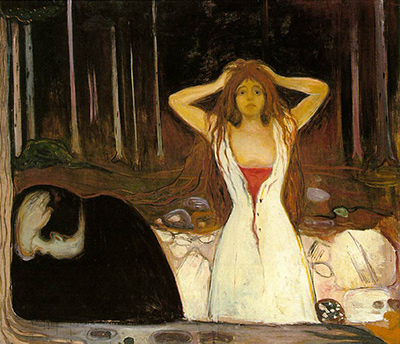Munch's 1894 painting Ashes is a striking image. A man crouches in the corner of the painting, while in the centre a woman in a white dress stands like some kind of totem, frontally posed and with her hands in her hair.
He's dressed in black, she's in white, and her hair is reddish gold - primal colours for a dream or fairy-tale scene. The titles, Ashes, is not evoked anywhere in the painting, but suggests that when love has burned too fast, ashes are all that's left. The man is clearly in despair; his face - what can be seen of it - is grey, as if he's already dead.
The woman's face is tragic, her eyes huge and brooding. There's something badly wrong; this is clearly more than a lover's tiff. In the background is a forest, perhaps the primordial forest of fairy stories. But Munch messes around with space of the painting. The strange border which begins in the left hand corner flows up into the forest, so that something which should be purely ornamental becomes, instead, part of the world of the painting.
The edge of the painting seems to force the man into his posture, squeezing him in; and the woman's hair seems to become the earth of the forest floor. Everything melts into something else, and nothing is real in the strange space of dream. On another level, Munch is showing details of his own affair with married woman Millie Thaulow. They used to meet in the woods, and here they are getting dressed afterwards; she is fixing her hair, though the way she is painted, it also looks as if she's tearing it out in the ancient gesture of mourning.
Her white dress isn't done up yet, and exposes her flagrant red underwear - symbol of unloosed sexuality. Munch seems to be addressing a sense of immense guilt - a guilt that here is equally shared between the two lovers. By setting it in the context of the forest he has done more than simply referring to the circumstances of his own life; he has created a powerful mythic image that still resonates today.




